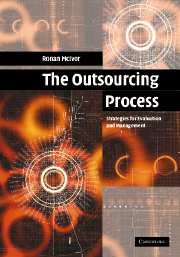Book contents
- Frontmatter
- Contents
- List of figures
- List of tables
- List of illustrations
- Acknowledgements
- 1 Introduction
- 2 The trend towards outsourcing
- 3 Theoretical influences on outsourcing
- 4 The outsourcing process: a framework for evaluation and management
- 5 Determining the current boundary of the organisation
- 6 Activity importance analysis
- 7 Capability analysis
- 8 An analysis of the strategic sourcing options
- 9 Developing the relationship strategy
- 10 Establish, manage and evaluate the relationship
- 11 Case study – outsourcing experiences at Telco
- 12 Conclusions
- Index
- References
11 - Case study – outsourcing experiences at Telco
Published online by Cambridge University Press: 21 August 2009
- Frontmatter
- Contents
- List of figures
- List of tables
- List of illustrations
- Acknowledgements
- 1 Introduction
- 2 The trend towards outsourcing
- 3 Theoretical influences on outsourcing
- 4 The outsourcing process: a framework for evaluation and management
- 5 Determining the current boundary of the organisation
- 6 Activity importance analysis
- 7 Capability analysis
- 8 An analysis of the strategic sourcing options
- 9 Developing the relationship strategy
- 10 Establish, manage and evaluate the relationship
- 11 Case study – outsourcing experiences at Telco
- 12 Conclusions
- Index
- References
Summary
Introduction
This case study focuses on a telecommunications equipment manufacturer. The telecommunications industry has been characterised by extensive outsourcing by original equipment manufacturers (OEMs) over the last few years due to issues such as shortening product cycles and time to market pressures. Many OEMs in this industry have increasingly become ‘systems integrators’; namely specialists in the management and co-ordination of production and service providers. This case study identifies the drivers that have influenced outsourcing in the telecommunications industry. The case organisation has outsourced many activities to suppliers including assembly operations, manufacturing, logistics and design. A central part of this strategy has been the adoption of more collaborative relationships with its key suppliers in order to reduce the risks associated with outsourcing. The company will be referred to as Telco for purposes of confidentiality. The implications of the outsourcing strategy are drawn from an analysis of this company and three cases of outsourcing evaluation and management over an 18-month period. These three case studies are related to the stages in the outsourcing framework presented in this book in order to illustrate both its explanatory and prescriptive nature. A critical evaluation of Telco's experience with outsourcing is carried out and in particular, its attempts to develop collaborative buyer–supplier relationships. The implications of the case organisation adopting a modular approach to the arrangement of its supply base are examined. Some of the issues developed in this case study are for illustrative purposes only.
- Type
- Chapter
- Information
- The Outsourcing ProcessStrategies for Evaluation and Management, pp. 276 - 310Publisher: Cambridge University PressPrint publication year: 2005

